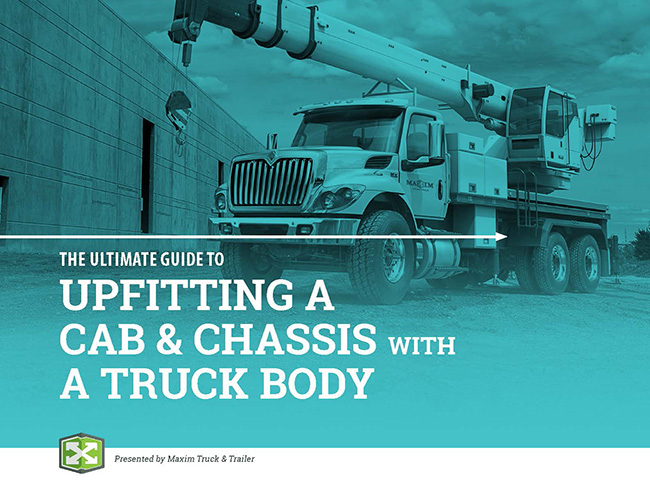
11 Questions to Ask Before Upfitting a Cab & Chassis with a Truck Body
 We sat down with one of Maxim's foremost experts with up-to-date and hands-on experience helping customers upfit their semi trucks.
We sat down with one of Maxim's foremost experts with up-to-date and hands-on experience helping customers upfit their semi trucks.Upfitting a Cab & Chassis with a Truck Body
You’ve seen trucks on roadways from city streets to the Trans-Canada Highway with all kinds of bodies attached to them, but have you ever won-dered how the various pieces come together? They don’t come off the as-sembly line as complete units. In fact, the truck chassis is completely sepa-rate from the body attached to it. Think about the dump trucks you see on the road or the five-ton delivery van bodies, cement mixers or fire trucks. A significant amount of engineering and effort goes into every truck chassis and body combination to make sure it’s optimal for every customer’s unique needs. At the same time, every combination ensures maximum safety for the driver which, in turn, makes the roads safer for everybody.
| 1 | What's the First Step? This is a custom-driven process and there’s nothing random about it. We have initial conversations with the customer to determine what their needs will be. Will they be on the highway or off-road? Are they carrying cargo? If so, what kind? Will they need any special capabilities? Essentially, we’ll find out exactly what the truck chassis and body combination needs to do for the customer. |
| 2 | Does the customer buy the completed truck chassis and body from the dealer or from the specialized body builders? The short answer is – it depends. For more straightforward bodies, like the common 24-foot to 26-foot dry van or refrigerated bodies, dealers keep a regular stock of these pre-built units on hand because they are so common. The same goes for dump trucks, deck trucks, water trucks, septic trucks and some plows and sanders. The commonality of specifications from one customer to another allows truck dealers to order stock units that they know will sell quickly. For example, the dealer will take a $150,000 truck chassis, install a $50,000 water tank on it and sell it as a completed unit on their lot for $200,000. However, for bodies that are more complicated and specialized – such as utility units with diggers and buckets where the body can cost more than the truck chassis – customers generally buy or tender their contracts directly via the body builder or truck equipment manufacturers). In these cases, the body builders will purchase the truck chassis from the dealer as a blank canvas and build their body onto it and sell the completed unit to the customer. A dealer building a specialized unit like this would take a huge risk that the completed unit would sit on their lot for months or even years until the right buyer looking for those exact specifications came along. |
| 3 |
What are some examples of common and not-so common truck bodies?
More complex builds:
|
| 4 | Can anyone add a body to a truck chassis? There are many companies out there that will tackle the job of adding a body to a truck chassis - but the risks of not knowing the regulations are significant. For example, you may want to install a van body and a pintle hitch on a truck chassis because you might be pulling a trailer. But some Department of Transportation (DOT) rules only allow pintle hitches installed and used on boxes with an overhang of three feet or less. If your install doesn’t fall within those parameters, it does not comply. So it’s important to ensure that any company or individual doing installations or alternations to a commercial vehicle travelling on public roadways is aware and complies with DOT regulations. In Canada, look for this seal to ensure your truck body was installed in compliance with Transport Canada regulations and is both legal and safe. In Ontario, make sure the company doing SPIF (Safe Productive Infrastructure Friendly) installations or alterations in or into Ontario are certified to do so by the Ontario Ministry of Transport |
| 5 | What is Maxim’s role with the truck equipment manufacturers? As a dealer, we make the installations of the bodies as seamless as possible for our customers. We assemble our truck to minimize the cost of installing the body and put everything together. Our job is to simplify solutions on body installation to reduce costs to our customers. The more informed our customers are about what we offer, the lower their costs will be because they won’t be buying unnecessary parts or adding unnecessary labour. Each Body Builder usually has a list of mandatory criteria that the truck chassis needs in order to work with the body they are installing. For example, the truck may need 16,000 lb front axles to handle a garbage compactor or specific cross members for a cement mixer to prevent frame twisting. At Maxim, we get this critical information BEFORE we spec your truck so there are no surprises or costly work-arounds required afterwards. |
| 6 |
How do you decide where to put the various pieces of equipment? |
| 7 | What are the main things body builders look for when pairing a truck chassis with a truck body? The key element is ease of installation on the truck body. It’s critical that the body be mounted as close to the back of the cab as possible so that the gap between the two is minimal. Six inches is a good benchmark. It’s also important that components, such as air tanks, filters, fuel tanks and exhaust systems, are laid out in such a way that they don’t impede the body installation. Our International Truck DLB (Diamond Logic Builder) framework, our multi-faceted electrical system, is the brains behind the components on the body. It not only simplifies and reduces the installation cost, but it also increases safety. For example, it features sensors that tell the driver if the tailgate is open. The truck can’t move until it’s closed so the DLB greatly reduces the chance of driver error. Maxim’s International Trucks have clear and convenient schematic drawings specific to each truck VIN that we can provide to the body builder to make the body installation much easier. These show which switch on the dash goes to which wiring outlet. This makes wiring accessories very easy for that truck. Without it, the body builder needs to use probing and test lights to find the right switch/wire combination which is time consuming and not very efficient. |
| 8 | Is it recommended to pair a used truck with a new body or a new truck with a used body to save money? In certain cases, installing a new body on a used chassis can make sense. For example, let’s consider a situation where you have a two-year-old truck that’s in great shape and costs $140,000 versus a new truck that costs $180,000. If you want to install a new $50,000 water tank, the used option would cost just $190,000, compared to $230,000 for the new vehicle. On the other hand, you want to upgrade your five-ton truck chassis and swap the box and tailgate from your old unit because it’s still in great shape. That could save you $30,000 to$50,000. So, on common bodies, mixing and matching new and used components can work. But for anything specialized like a utility unit, the downside far outweighs the upside. |
| 9 | How does the technology on the truck chassis work with the eventual body that gets installed on the truck? The Diamond Logic System, or DLS, featured on international trucks, is our onboard computer that maximizes efficiency and safety. The more of the operations that we can take away from the driver, the less chance there is of them having an accident. For example, we’ll put safety interlocks with a dump truck that tells the driver if the box is up. A sensor will beep constantly while it’s in the air and won’t stop until the box goes back to the resting position. We have switches on the dash to make the box go up and down and the gate to open and close. Other manufacturers don’t have that functionality. We’ve all seen videos on the Internet of a dump truck attempting to drive under an overpass while the box is up and the box getting destroyed. Our trucks will never go viral in this way. |
| 10 | Can you program the switches to make the body functions operate from inside the cab and increase safety? Yes. Utility trucks have outriggers that emerge from the sides to support the truck when workers in the basket are changing lights 80 feet above ground. We program our safety interlocks here to take driver error out of the equation. When the driver gets back in the truck, a light will blink on the dash to indicate that the riggers haven’t been stowed properly so they won’t drive away with the bucket in the air. We can even program the truck so the driver can’t put it in drive if the riggers haven’t been stowed. |
| 11 | The trucking industry has experienced driver shortages for years. How does technology play a role in helping drivers today? Drivers aren’t trained today the way they used to be. There are many more inexperienced drivers out there on the road today, but our safety interlocks help them operate our equipment in a safe fashion. Our job is to take the as much of the truck body operation away from the driver so they can focus on driving the truck. The safety interlocks reduce the worry that they’re doing something wrong due to their lack of experience. The number of factory options we can supply to our body builders maximizes our savings and simplifies the installation of the bodies while making the safest possible truck for our client. Safety isn’t just for our drivers –it’s for everybody else on the road, too. |







